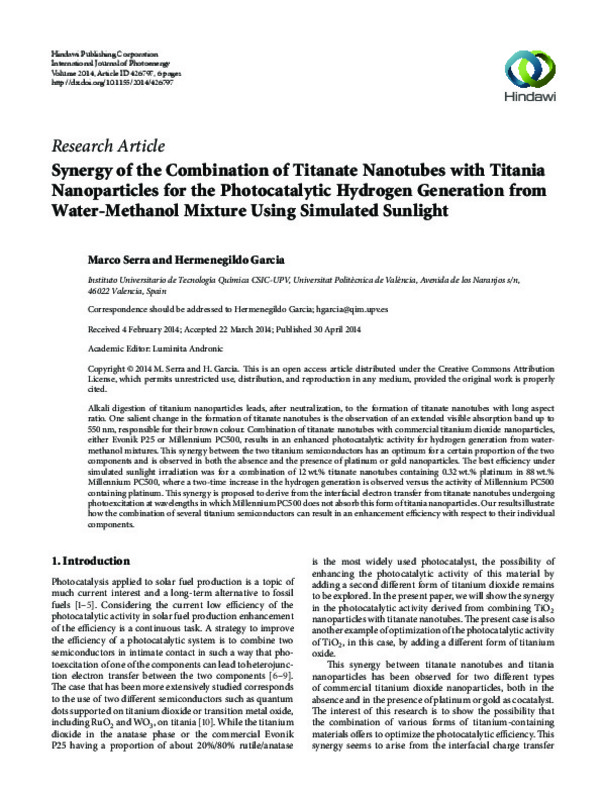Centi, G., & Perathoner, S. (2010). Towards Solar Fuels from Water and CO2. ChemSusChem, 3(2), 195-208. doi:10.1002/cssc.200900289
Gust, D., Moore, T. A., & Moore, A. L. (2009). Solar Fuels via Artificial Photosynthesis. Accounts of Chemical Research, 42(12), 1890-1898. doi:10.1021/ar900209b
Hammarström, L. (2009). Artificial Photosynthesis and Solar Fuels. Accounts of Chemical Research, 42(12), 1859-1860. doi:10.1021/ar900267k
[+]
Centi, G., & Perathoner, S. (2010). Towards Solar Fuels from Water and CO2. ChemSusChem, 3(2), 195-208. doi:10.1002/cssc.200900289
Gust, D., Moore, T. A., & Moore, A. L. (2009). Solar Fuels via Artificial Photosynthesis. Accounts of Chemical Research, 42(12), 1890-1898. doi:10.1021/ar900209b
Hammarström, L. (2009). Artificial Photosynthesis and Solar Fuels. Accounts of Chemical Research, 42(12), 1859-1860. doi:10.1021/ar900267k
Roy, S. C., Varghese, O. K., Paulose, M., & Grimes, C. A. (2010). Toward Solar Fuels: Photocatalytic Conversion of Carbon Dioxide to Hydrocarbons. ACS Nano, 4(3), 1259-1278. doi:10.1021/nn9015423
Khan, G., Choi, S. K., Kim, S., Lim, S. K., Jang, J. S., & Park, H. (2013). Carbon nanotubes as an auxiliary catalyst in heterojunction photocatalysis for solar hydrogen. Applied Catalysis B: Environmental, 142-143, 647-653. doi:10.1016/j.apcatb.2013.05.075
Marschall, R. (2013). Semiconductor Composites: Strategies for Enhancing Charge Carrier Separation to Improve Photocatalytic Activity. Advanced Functional Materials, 24(17), 2421-2440. doi:10.1002/adfm.201303214
Rawal, S. B., Bera, S., Lee, D., Jang, D.-J., & Lee, W. I. (2013). Design of visible-light photocatalysts by coupling of narrow bandgap semiconductors and TiO2: effect of their relative energy band positions on the photocatalytic efficiency. Catalysis Science & Technology, 3(7), 1822. doi:10.1039/c3cy00004d
Wu, L., Xing, J., Hou, Y., Xiao, F. Y., Li, Z., & Yang, H. G. (2013). Fabrication of Regular ZnO/TiO2Heterojunctions with Enhanced Photocatalytic Properties. Chemistry - A European Journal, 19(26), 8393-8396. doi:10.1002/chem.201300849
Sayama, K., Yoshida, R., Kusama, H., Okabe, K., Abe, Y., & Arakawa, H. (1997). Photocatalytic decomposition of water into H2 and O2 by a two-step photoexcitation reaction using a WO3 suspension catalyst and an Fe3+/Fe2+ redox system. Chemical Physics Letters, 277(4), 387-391. doi:10.1016/s0009-2614(97)00903-2
Crabtree, G. W., Dresselhaus, M. S., & Buchanan, M. V. (2004). The Hydrogen Economy. Physics Today, 57(12), 39-44. doi:10.1063/1.1878333
Dunn, S. (2002). Hydrogen futures: toward a sustainable energy system. International Journal of Hydrogen Energy, 27(3), 235-264. doi:10.1016/s0360-3199(01)00131-8
Esswein, A. J., & Nocera, D. G. (2007). Hydrogen Production by Molecular Photocatalysis. Chemical Reviews, 107(10), 4022-4047. doi:10.1021/cr050193e
Jensen, S. H., Larsen, P. H., & Mogensen, M. (2007). Hydrogen and synthetic fuel production from renewable energy sources. International Journal of Hydrogen Energy, 32(15), 3253-3257. doi:10.1016/j.ijhydene.2007.04.042
Navarro, R. M., Sánchez-Sánchez, M. C., Alvarez-Galvan, M. C., Valle, F. del, & Fierro, J. L. G. (2009). Hydrogen production from renewable sources: biomass and photocatalytic opportunities. Energy Environ. Sci., 2(1), 35-54. doi:10.1039/b808138g
Ni, M., Leung, M. K. H., Leung, D. Y. C., & Sumathy, K. (2007). A review and recent developments in photocatalytic water-splitting using TiO2 for hydrogen production. Renewable and Sustainable Energy Reviews, 11(3), 401-425. doi:10.1016/j.rser.2005.01.009
NOWOTNY, J., SORRELL, C., SHEPPARD, L., & BAK, T. (2005). Solar-hydrogen: Environmentally safe fuel for the future. International Journal of Hydrogen Energy, 30(5), 521-544. doi:10.1016/j.ijhydene.2004.06.012
Tsai, C.-C., & Teng, H. (2006). Structural Features of Nanotubes Synthesized from NaOH Treatment on TiO2with Different Post-Treatments. Chemistry of Materials, 18(2), 367-373. doi:10.1021/cm0518527
Chen, X., Liu, L., Yu, P. Y., & Mao, S. S. (2011). Increasing Solar Absorption for Photocatalysis with Black Hydrogenated Titanium Dioxide Nanocrystals. Science, 331(6018), 746-750. doi:10.1126/science.1200448
Primo, A., Marino, T., Corma, A., Molinari, R., & García, H. (2011). Efficient Visible-Light Photocatalytic Water Splitting by Minute Amounts of Gold Supported on Nanoparticulate CeO2Obtained by a Biopolymer Templating Method. Journal of the American Chemical Society, 133(18), 6930-6933. doi:10.1021/ja2011498
Gomes Silva, C., Juárez, R., Marino, T., Molinari, R., & García, H. (2011). Influence of Excitation Wavelength (UV or Visible Light) on the Photocatalytic Activity of Titania Containing Gold Nanoparticles for the Generation of Hydrogen or Oxygen from Water. Journal of the American Chemical Society, 133(3), 595-602. doi:10.1021/ja1086358
Bamwenda, G. R., Tsubota, S., Kobayashi, T., & Haruta, M. (1994). Photoinduced hydrogen production from an aqueous solution of ethylene glycol over ultrafine gold supported on TiO2. Journal of Photochemistry and Photobiology A: Chemistry, 77(1), 59-67. doi:10.1016/1010-6030(94)80009-x
Haruta, M. (1997). Size- and support-dependency in the catalysis of gold. Catalysis Today, 36(1), 153-166. doi:10.1016/s0920-5861(96)00208-8
Serpone, N., Emeline, A. V., Horikoshi, S., Kuznetsov, V. N., & Ryabchuk, V. K. (2012). On the genesis of heterogeneous photocatalysis: a brief historical perspective in the period 1910 to the mid-1980s. Photochemical & Photobiological Sciences, 11(7), 1121. doi:10.1039/c2pp25026h
Aprile, C., Corma, A., & Garcia, H. (2008). Enhancement of the photocatalytic activity of TiO2through spatial structuring and particle size control: from subnanometric to submillimetric length scale. Phys. Chem. Chem. Phys., 10(6), 769-783. doi:10.1039/b712168g
[-]









